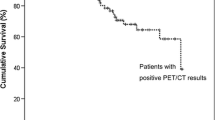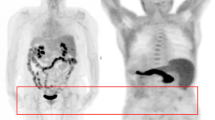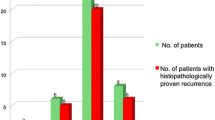Abstract
Purpose
To review the F-18 FDG PET/CT findings of metastatic ovarian tumors and to determine any correlation between FDG uptake by metastatic ovarian tumors and that by the primary tumors.
Methods
PET/CT performed from June 2005 to March 2011 on patients with metastatic ovarian tumors of gastrointestinal tract origin malignancies was analyzed retrospectively. The SUVmax of metastatic ovarian tumors and primary tumors, when available, was measured.
Results
Thirty-two patients were included. Of the 32 cases, 20 had metastatic tumors in bilateral ovaries and 12 had in a single ovary. The mean SUVmax of the 52 total lesions was 4.1 ± 3.1 (range 1.2–13.3), and 46 lesions showed a heterogeneous FDG uptake pattern. In 22 cases with available primary tumor SUVmax values, there was a moderate positive correlation with the SUVmax of the corresponding metastatic tumors (r = 0.559, p = 0.007). There was no significant correlation between the size and SUVmax of metastatic ovarian tumors (p = 0.128). The mean SUVmax of metastatic ovarian tumors from colorectal cancers was significantly higher than that of stomach cancers (p = 0.039).
Conclusions
Metastatic ovarian tumors showed FDG uptake of variable intensity, depending on the primary tumor type. The FDG uptake pattern was heterogeneous by PET imaging in vast majority of the cases. When the primary tumor demonstrates a low FDG uptake, careful evaluation is necessary since the metastatic ovarian tumors may also show low FDG uptake.





Similar content being viewed by others
References
Brown DL, Zou KH, Tempany CM et al (2001) Primary versus secondary ovarian malignancy: imaging findings of adnexal masses in the radiology diagnostic oncology group study. Radiology 219:213–218
Cheong JH, Hyung WJ, Chen J et al (2004) Surgical management and outcome of metachronous Krukenberg tumors from gastric cancer. J Surg Oncol 87:39–45
Choi HJ, Lee JH, Seo SS et al (2005) Computed tomography findings of ovarian metastases from colon cancer: comparison with primary malignant ovarian tumors. J Comput Assist Tomogr 29:69–73
de Waal YR, Thomas CM, Oei AL et al (2009) Secondary ovarian malignancies: frequency, origin, and characteristics. Int J Gynecol Cancer 19:1160–1165
Fujiwara K, Ohishi Y, Koike H et al (1995) Clinical implications of metastases to the ovary. Gynecol Oncol 59:124–128
Jiang R, Tang J, Cheng X et al (2009) Surgical treatment for patients with different origins of Krukenberg tumors: outcomes and prognostic factors. Eur J Surg Oncol 35:92–97
Jung SE, Lee JM, Rha SE et al (2002) CT and MR imaging of ovarian tumors with emphasis on differential diagnosis. Radiographics 22:1305–1325
Khunamornpong S, Suprasert P, Chiangmai WN et al (2006) Metastatic tumors to the ovaries: a study of 170 cases in northern Thailand. Int J Gynecol Cancer 16(Suppl 1):132–138
Kim SH, Kim WH, Park KJ et al (1996) CT and MR findings of Krukenberg tumors: comparison with primary ovarian tumors. J Comput Assist Tomogr 20:393–398
Kim HK, Heo DS, Bang YJ et al (2001) Prognostic factors of Krukenberg’s tumor. Gynecol Oncol 82:105–109
Kim SK, Kang KW, Roh JW et al (2005) Incidental ovarian 18F-FDG accumulation on PET: correlation with the menstrual cycle. Eur J Nucl Med Mol Imaging 32:757–763
Kim YI, Kim SK, Lee JW et al (2010) Ovarian mass mimicking malignancy: a case report Nucl Med. Mol Imaging 44:290–293
Kitajima K, Murakami K, Sakamoto S et al (2011a) Present and future of FDG-PET/CT in ovarian cancer. Ann Nucl Med 25:155–164
Kitajima K, Suzuki K, Senda M et al (2011b) FDG-PET/CT for diagnosis of primary ovarian cancer. Nucl Med Commun 32:549–553
Kitajima K, Suzuki K, Senda M et al (2011c) FDG PET/CT features of ovarian metastasis. Clin Radiol 66:264–268
Koyama T, Mikami Y, Saga T et al (2007) Secondary ovarian tumors: spectrum of CT and MR features with pathologic correlation. Abdom Imaging 32:784–795
Lee SJ, Bae JH, Lee AW et al (2009) Clinical characteristics of metastatic tumors to the ovaries. J Korean Med Sci 24:114–119
Lerman H, Metser U, Grisaru D et al (2004) Normal and abnormal 18F-FDG endometrial and ovarian uptake in pre- and postmenopausal patients: assessment by PET/CT. J Nucl Med 45:266–271
Lim JS, Yun MJ, Kim MJ et al (2006) CT and PET in stomach cancer: preoperative staging and monitoring of response to therapy. Radiographics 26:143–156
Liu Y (2009) Benign ovarian and endometrial uptake on FDG PET-CT: patterns and pitfalls. Ann Nucl Med 23:107–112
Megibow AJ, Hulnick DH, Bosniak MA et al (1985) Ovarian metastases: computed tomographic appearances. Radiology 156:161–164
Moore RG, Chung M, Granai CO et al (2004) Incidence of metastasis to the ovaries from nongenital tract primary tumors. Gynecol Oncol 93:87–91
Petru E, Pickel H, Heydarfadai M et al (1992) Nongenital cancers metastatic to the ovary. Gynecol Oncol 44:83–86
Prakash P, Cronin CG, Blake MA (2010) Role of PET/CT in ovarian cancer. AJR Am J Roentgenol 194:W464–W470
Risum S, Loft A, Høgdall C et al (2011) Standardized FDG uptake as a prognostic variable and as a predictor of incomplete cytoreduction in primary advanced ovarian cancer. Acta Oncol 50:415–419
Robbins SL, Kumar V, Cotran RS (2010) Robbins and cotran pathologic basis of disease, 8th edn. Saunders/Elsevier, Philadelphia
Ulbright TM, Roth LM, Stehman FB (1984) Secondary ovarian neoplasia. A clinicopathologic study of 35 cases. Cancer 53:1164–1174
Von Schulthess GK, Hany TF (2008) Imaging and PET-PET/CT imaging. J Radiol 89(3 Pt 2):438–448
von Schulthess GK, Steinert HC, Hany TF (2006) Integrated PET/CT: current applications and future directions. Radiology 238:405–422
Webb MJ, Decker DG, Mussey E (1975) Cancer metastatic to the ovary: factors influencing survival. Obstet Gynecol 45:391–396
Yada-Hashimoto N, Yamamoto T, Kamiura S et al (2003) Metastatic ovarian tumors: a review of 64 cases. Gynecol Oncol 89:314–317
Young RH (2006) From krukenberg to today: the ever present problems posed by metastatic tumors in the ovary: part I. Historical perspective, general principles, mucinous tumors including the krukenberg tumor. Adv Anat Pathol 13:205–227
Conflict of interest
The authors declare that they have no conflict of interest.
Ethical standard
This article does not contain any studies with animals performed by any of the authors.
Author information
Authors and Affiliations
Corresponding author
Rights and permissions
About this article
Cite this article
Park, H.L., Yoo, I.R., O, J.H. et al. F-18 FDG PET/CT findings of metastatic ovarian tumors from gastrointestinal tract origin. J Cancer Res Clin Oncol 141, 1871–1878 (2015). https://doi.org/10.1007/s00432-015-1978-2
Received:
Accepted:
Published:
Issue Date:
DOI: https://doi.org/10.1007/s00432-015-1978-2




